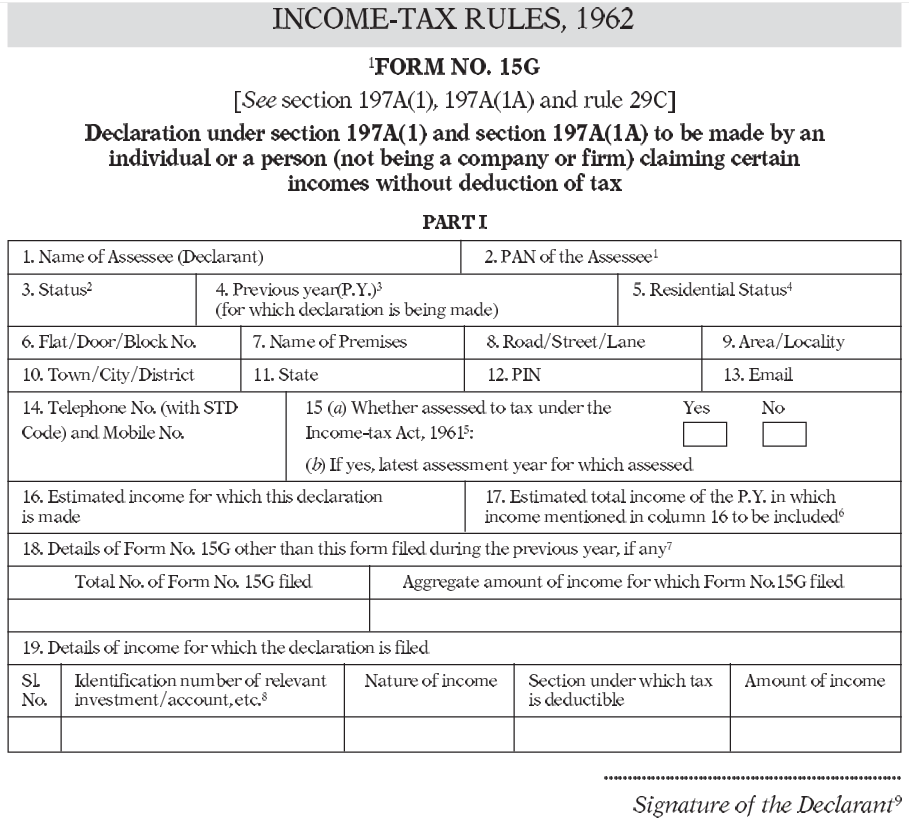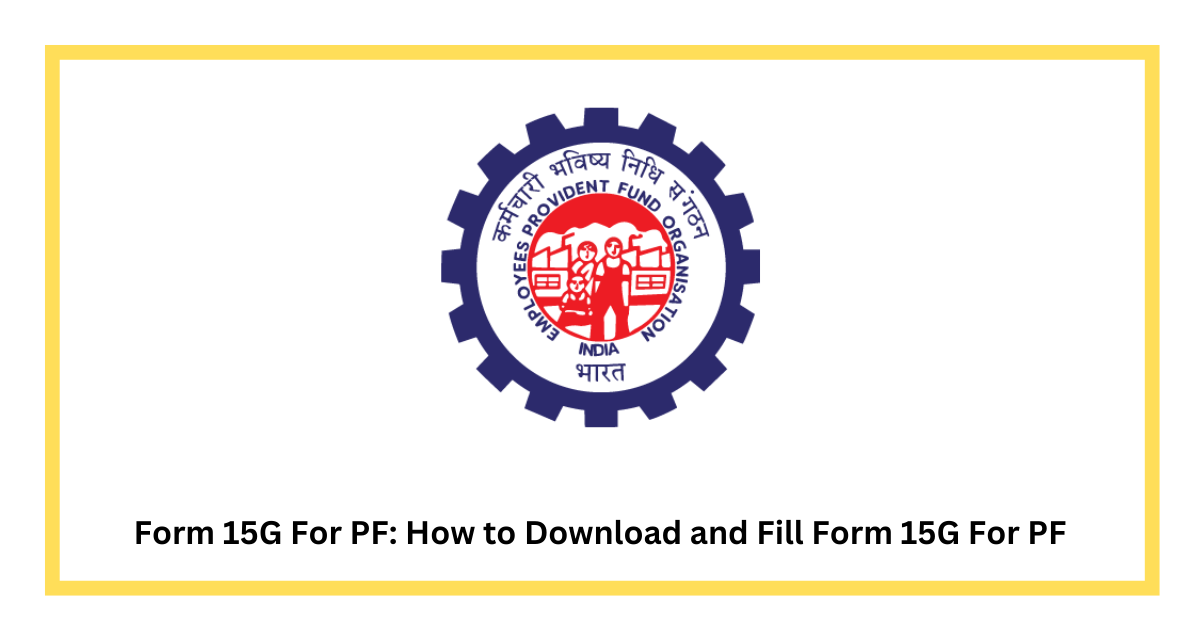Fixed deposit holders (individuals under 60 years old and HUFs) can fill out Form 15G as a declaration to ensure that no TDS (tax deduction at source) is taken from their interest income during the course of a year. Banks are required to deduct tax at source (TDS) from any interest you get on a fixed deposit, recurring deposit, etc.
What is 15G Form?
15G Form is a declaration form. People can use it to state that their income is below the tax threshold. This means they are exempt from paying taxes on interest received from certain investments like fixed deposits, recurring deposits, or EPF withdrawals. By using this form, people can avoid having tax deducted at source (TDS) from these earnings. Lets have a look at how to download and fill form 15G for pf.
|
Latest Update People whose PAN is not updated with the records in the EPFO will benefit from a reduction in the TDS rate on EPF withdrawal. The TDS rate was previously 30%, but it has been suggested that it be lowered to 20%. |
What is EPF Form 15 G?
The Employee Provident Fund (EPF) Form 15 G is a special variation of Form 15G that is used for withdrawals from the EPF. EPF members can declare that their entire income, including interest from EPF, is below the taxable threshold set by the Income Tax Department by filling out this form. If qualified, they might ask for tax relief on the interest earned from their EPF withdrawal.
How to Download and Fill Form 15G For PF Withdrawal?
To download and fill out Form 15G for PF withdrawal, follow these steps:
1. Download Form 15G: You can download Form 15G from the EPFO’s online portal or from the websites of major banks in India.
2. Fill out the form: Fill in the required details, such as your name, PAN card number, income tax status, residential status, address details, and contact information.
3. Declare the withdrawal amount: Mention the total estimated income of the financial year in which you plan to withdraw the PF.
4. Avoid TDS deductions: If you want to avoid TDS deductions, fill out Form 15G and submit it to the bank branch or EPFO regional office. Form 15G is mandatory if you don’t want TDS to be deducted from the PF withdrawal amount.
5. Submit the form: You can submit Form 15G online via EPFO’s online portal or through the website of major banks in India. Alternatively, you can submit the physical copy to the EPFO regional office for non-deduction purposes.
Please note that Form 15G is mandatory for individuals and HUFs (Hindu Undivided Families) below 60 years of age. For individuals aged 60 years and above, Form 15H is applicable.
15G Form Online
You can download Form 15G from the EPF portal or the official website of the Income Tax Department. Here is a sample of 15G Form.

How to Complete EPF Form 15G: A Step-By-Step Guide
The EPF form 15G should be filled out independently after you are aware of when TDS is relevant and when it is not. Here, we’ll discuss two distinct procedures: how to fill out and upload your EPF Form 15G.
Use Vakilsearch`s EPF Calculator India to decide out how an entire lot coins is probably amassed for your EPF account even as you retire.
You can upload your EPF Form 15 G online in a few easy minutes by following the steps below:
- You must first sign onto the online EPFO UAN portal – https://unifiedportal-mem.epfindia.gov.in/memberinterface/
- Claims can be chosen by clicking the ‘Online Services’ option.
- For the purpose of verification, you must now input the last four numbers of your registered bank account.
- You can upload your Form 15G by selecting it under the ‘I wish to apply for’ option.
The steps for completing your Form 15G are simply described here. It’s crucial to remember that EPF Form 15G is split into two sections:
Section 1 is for people who want to claim not to have TDS deducted from certain revenues. These people must complete the following fields on their EPF Form 15G:
- Field 1: As it appears on the PAN card, the Declarant’s or Assessee’s name
- Field 2: PAN card of the Assessee – Required; if the assessee doesn’t have a PAN card, Form 15G would be deemed invalid
- Field 3: Your position in terms of income tax is determined by whether you are an individual, HUF, or AOP.
- Field 4: Previous Year – This phrase refers to the prior fiscal year for which no TDS was deducted
- Field 5: Considering that NRIs are not permitted to submit Form 15G, a residential address is necessary
- Field 6-12: Address and PIN Code: For communication purposes
- Field 13-14: Email address and phone number are required for communication
- Field 15(a): Check the box next to ‘Yes’ if you had income tax levied against you under the Income Tax Act of 1961.
- Field 15(b): Mention the most recent assessment year of returns if you checked the box in Field 15 (a)
- Field 16: estimated income used in making this assessment
- Field 17: total anticipated income from the prior year (also include the income mentioned in Field 16)
- Field 18: Describe Form 15G in detail if you submitted it the prior year
- Field 19: You must include information about the income you’re declaring in this declaration.
Keep in mind that the last section of Form 15G is where you must complete the specifics of the investment for which this statement is being submitted. Term deposit, life insurance, employee code, and other investment account numbers must also be entered.
The person who will actually deposit your TDS to the government on your behalf, commonly known as the deductor, must fill out the second portion of the form.
Is Form 15G Mandatory for PF Withdrawal?
No, Form 15G is not required for PF withdrawals of less than ₹50,000.
Did you know that completing Form 15G can be helpful if your interest earnings total more than ₹40,000 every financial year? Although it’s not mandatory, here are several benefits of doing so:
- Filling out Form 15G stops Tax Deducted at Source (TDS) from being debited if your yearly income falls below the level at which you are exempt from paying income tax, allowing you to avoid paying any further taxes.
- You receive a TDS certificate for submitting your income tax return and paying any outstanding tax if your total yearly income exceeds the exemption threshold and you do not fill out Form 15G.
Can We Submit Form 15G for PF Withdrawal?
Yes! You can submit Form 15G for PF withdrawal through the official website of the EPFO (Employees’ Provident Fund Organisation). The UAN (Universal Account Number) portal could also be used.
How to Fill Form 15G for PF Withdrawal?
To fill Form 15G for PF withdrawal:
- Provide personal details including name, PAN (Permanent Account Number), address, and other required information.
- Declare your eligibility criteria.
- Sign the form before submission.
How Much Amount of PF Interest Is Tax-Free?
Up to ₹2.5 lakh of EPF contributions per year are tax-free. Any interest on contributions beyond this limit will be taxed annually from the employee.
You can cut down on TDS from your interest income now that you know how to download form 15G and complete Form 15G. However, under Section 277 of the Income Tax Act, anyone who falsely disclose Form 15G to avoid tax deduction at source is subject to fines or jail.
Form 15G for Corporate Bonds or Debentures
It is applicable to anyone under the age of 60 whose combined income is less than the taxable threshold.
Individuals can advise the payer that they are not required to pay tax on the interest income. The payer should not withhold any tax at source by filing Form 15G.
At the start of the fiscal year in which interest income is anticipated, this form must be turned in.
To avoid any fines or legal repercussions, it is crucial to supply accurate information and make sure that the requirements listed in the form are completed.
Form 15G for Life Insurance Policy
Form 15G can also be used to avoid the deduction of tax at source on the income earned from life insurance policies.
Individuals who are below the age of 60 and whose total income falls below the taxable threshold can submit this form to their insurance company.
By submitting Form 15G, individuals declare that they are not liable to pay tax on the income earned from the life insurance policy and request the insurance company not to deduct any tax at source.
This form needs to be submitted at the beginning of the financial year in which the income is expected.
It is essential to provide accurate information and ensure that the conditions mentioned in the form are satisfied to avoid any penalties or legal consequences.
Form 15G for Rental Income
Form 15G is not applicable for rental income. It is specifically meant for certain types of interest income.
If you receive rental income, you cannot use Form 15G to prevent tax deduction at source.
Rental income is subject to tax, and the person paying the rent is required to deduct tax at the source as per the applicable rates.
Individuals who receive rental income need to report it in their income tax return and pay taxes accordingly.
Form 15G and 15H
- Both Form 15G and Form 15H serve the same purpose of preventing the deduction of tax at source on certain types of income.
- Form 15G is meant for individuals who are below the age of 60 and whose total income is below the taxable threshold.
- Form 15H, on the other hand, is for individuals who are 60 years or above or those who meet certain specified criteria and whose total income falls below the taxable threshold.
- By submitting these forms, individuals declare that they are not liable to pay tax on the specified income and request the payer not to deduct any tax at source.
- The forms need to be submitted at the beginning of the financial year in which the income is expected.
- It is important to provide accurate information and ensure that the conditions mentioned in the forms are met to avoid any penalties or legal consequences.
Where to Get Form 15G?
- Form 15G can be obtained from the Income Tax Department’s official website (www.incometaxindia.gov.in).
- It is available in both physical and electronic formats.
- Many banks and financial institutions also provide Form 15G at their branches or on their websites.
- Individuals can download the form, fill it out with the required details, and submit it to the relevant payer.
TDS on EPF Withdrawal Rules
- EPF Registration stands for Employee Provident Fund, which is a retirement savings scheme managed by the government of India.
- When an individual withdraws funds from their EPF account before completing a certain number of years of service, tax is deducted at source (TDS) on the withdrawal amount.
- The TDS rates for EPF withdrawal depend on various factors, such as the total withdrawal amount and the period of service.
- If the EPF withdrawal amount is less than Rs. 50,000 and the individual has completed five years of continuous service, no TDS is deducted.
- However, if the withdrawal amount exceeds Rs. 50,000 and the individual has not completed five years of continuous service, TDS is deducted at a specific rate.
- The current TDS rate for such withdrawals is 10% if the individual has provided their Permanent Account Number (PAN). If PAN is not provided, the TDS rate increases to 20%.
- It is important to note that the TDS deducted is not the final tax liability. Individuals need to report the EPF withdrawal in their income tax return and calculate the final tax liability based on their overall income for the financial year.
Where to Get Form 15G?
Form 15G can easily be available on the Income Tax Department’s official website. A designated bank branch also provides the form.
It is accessible in neighbourhood income tax offices and can be downloaded from banks’ and financial instituitions’ websites.
TDS on EPF Withdrawal Rules
- When an individual withdraws money from their Employee Provident Fund (EPF) account, tax is deducted at source (TDS) if certain conditions are met.
- The current TDS threshold for EPF withdrawal is ₹50,000. If the total amount of withdrawal exceeds this threshold, TDS is applicable.
- If the individual has not provided their Permanent Account Number (PAN), TDS is deducted at a higher rate of 20% instead of the normal rate of 10%.
- In case the individual has submitted Form 15G or 15H (applicable for senior citizens), TDS will not be deducted if the total income for the financial year is below the taxable limit.
TDS Application Rules
- TDS is applicable on various types of income, such as salaries, interest, rent, etc.
- The deductor (person responsible for deducting TDS) needs to obtain a Tax Deduction and Collection Account Number (TAN) and deduct TDS at the prescribed rates.
- The TDS deducted needs to be deposited to the government within the specified due dates.
- The deductor must issue a TDS certificate to the deductee (the person from whom TDS is deducted) as proof of tax deduction.
- The deductee can claim the TDS amount as a tax credit while filing their income tax return.
Step by Step for How to Fill EPF Form 15G
- Download Form 15G from the official website of the Income Tax Department or obtain it from a bank branch.
- Fill in the personal details such as name, address, PAN, etc.
- Mention the relevant financial year for which the declaration is being made.
- Provide details of the previous year’s total income and tax deducted at source (if any).
- Declare that the individual’s total income for the current financial year will be below the taxable limit.
- Sign the declaration form.
- Submit the filled and signed Form 15G to the concerned bank or financial institution.
How To Download PF Withdrawal Form 15G Online?
- Visit the official website of the Income Tax Department or the website of your bank.
- Search for the option to download Form 15 G.
- Click on the download link to obtain the form in PDF format.
- Save the form to your computer or mobile device.
- Print the form and fill it out manually with the required details.
- Alternatively, you can also fill out the form electronically by using a PDF editor or by importing it into a document editing software.
- After filling the form, sign it and submit it to the designated bank or financial institution.
Eligibility Criteria For Submitting Form 15 G
- Individuals who are below 60 years of age can submit Form 15 G to declare that their total income for the financial year is below the taxable limit.
- The form is applicable for individuals who are Indian residents and fulfill the criteria mentioned in the Income Tax Act, 1961.
- It is important to accurately assess and ensure that the total income, including interest income, is below the taxable limit before submitting Form 15 G.
What Are The Penalties For Filing False Declaration in Form 15 G?
- Filing a false declaration in Form 15 G is considered a serious offense and can attract penalties under the Income Tax Act.
- If the assessing officer finds that the declaration was false and the individual’s total income exceeds the taxable limit, the officer can initiate proceedings for tax evasion.
- Penalties can include payment of tax dues along with interest, prosecution under the Income Tax Act, and imposition of penalties ranging from 100% to 300% of the tax amount evaded.
- It is important to provide truthful and accurate information in Form 15G to avoid legal consequences and potential financial liabilities.
Is 15G compulsory for PF withdrawal?
No, it is not compulsory but it is important for tax deduction.
What is form 15G for PF claim?
Form 15G is a declaration to be submitted for claiming exemption from TDS on PF withdrawal.
Who is eligible for 15G form?
Individuals whose total income is below the taxable limit can submit Form 15G.
Where to submit form 15G for PF withdrawal?
Form 15G needs to be submitted to the concerned bank or financial institution handling the PF withdrawal.
What happens if 15G is not submitted for PF?
TDS will be deducted from the PF withdrawal amount if Form 15G is not submitted.
When should Form 15G be submitted?
Form 15G should be submitted before the first payment of income on which TDS is applicable.
What is income limit for Form 15G?
The income limit for submitting Form 15G is currently set at the taxable limit, which is subject to change.
Can a salaried person submit Form 15G?
Yes, a salaried person can submit Form 15G if their total income is below the taxable limit.
How much amount of PF is tax free?
The entire amount of PF withdrawal is tax-free if certain conditions are met.
How much PF is taxable?
PF withdrawal is taxable if the total service period is less than 5 years.
How to fill form 15G for PF withdrawal sample?
Refer to the provided sample or the official Form 15G for instructions on filling the form.
How to file 15G online?
The process for filing Form 15G online may vary depending on the platform or website used. Follow the instructions provided on the respective portal.
Is form 15H mandatory for PF withdrawal after retirement?
No, Form 15H is applicable for senior citizens, while Form 15G is for individuals below 60 years of age.
What is the use of Form 15G?
Form 15G is used to declare that the individual's total income is below the taxable limit and claim exemption from TDS.
What is the eligibility criteria for submitting Form 15G?
Individuals below 60 years of age, Indian residents, and having income below the taxable limit are eligible to submit Form 15G.
Is a PAN card necessary for filing Form 15G?
Yes, providing a PAN card is mandatory when filing Form 15G.
Do I need to fill out Part 2 of Form 15G?
Part 2 of Form 15G needs to be filled out only if the individual has been allotted a Certificate of Assessing Officer for non-deduction of TDS.
When should I submit Form 15G for PF withdrawal?
Form 15G should be submitted before the first payment of income subject to TDS, which includes PF withdrawal.
What is the penalty for form 15G?
Filing a false Form 15G can lead to penalties, including payment of tax dues, prosecution, and imposition of penalties ranging from 100% to 300% of the tax amount evaded.
Who is not eligible for 15G?
Individuals whose total income exceeds the taxable limit are not eligible to submit Form 15G.
How can I download Form 15G for PF claim?
You can download Form 15G for PF withdrawal from EPFO's online portal or the websites of major banks. Simply log in and search for PF Form 15G download, and you can download it to your computer or smartphone.
How can I download and fill Form 15G?
You can download Form 15G from EPFO's online portal or the websites of major banks. After downloading, you can fill it out by stating that your income is below the taxable limit. You are required to fill out only Part I of Form 15G for PF withdrawal. Follow the instructions to fill up the other fields in Form 15G. After filling in all the fields, cross-check all the details to ensure there is no error.
Is 15G compulsory for PF withdrawal?
Form 15G is mandatory if you don't want TDS to be deducted from the PF withdrawal amount. Section 192A of the Finance Act 2015 states that PF withdrawal will attract TDS if the withdrawal amount is more than Rs.50,000 and your employment tenure is of less than 5 years. For a PF withdrawal of less than Rs.50,000, Form 15G is not mandatory.
What if I forgot to fill Form 15G?
If you forget to fill out Form 15G, TDS will be deducted from your PF withdrawal amount if the withdrawal amount is more than Rs.50,000 and your employment tenure is of less than 5 years. The TDS rate is 10% for such withdrawals. If your PAN card is not updated with your PF account, the TDS will be as high as 30%.
How can I withdraw my full PF amount?
To withdraw your full PF amount, you need to fill out Form 19. You can submit this form online through the EPFO portal or offline by visiting the nearest EPFO office. You will also need to submit a cancelled cheque and a copy of your PAN card.
Which form to fill for full PF withdrawal?
You need to fill out Form 19 for full PF withdrawal.
Is Form 15H mandatory for PF withdrawal after retirement?
No, Form 15H is not mandatory for PF withdrawal after retirement.
What happens if I forget to submit form 15G for PF withdrawal?
If you forget to submit Form 15G, TDS will be deducted from your PF withdrawal amount if the withdrawal amount is more than Rs.50,000 and your employment tenure is of less than 5 years. The TDS rate is 10% for such withdrawals. If your PAN card is not updated with your PF account, the TDS will be as high as 30%.
What is the time limit for form 15G?
There is no specific time limit for submitting Form 15G for PF withdrawal. However, it is recommended to submit the form as soon as possible to avoid TDS deductions from your PF withdrawal amount
Read more:
- How Many Employees Required for PF Registration
- Steps on PF Nominee Update
- Complete steps for EPFO Password change









